Russula mushrooms are a massive genus of mushrooms that can be found around the world. The genus has many species, both edible and inedible, and you’ll definitely want to study up on them before heading out to forage.
The mushrooms are both unique and distinctive and, unlike morels, or cauliflower mushrooms, they are extremely common and pretty much everywhere.
Let’s take a look at these fascinating mushrooms.
Classification
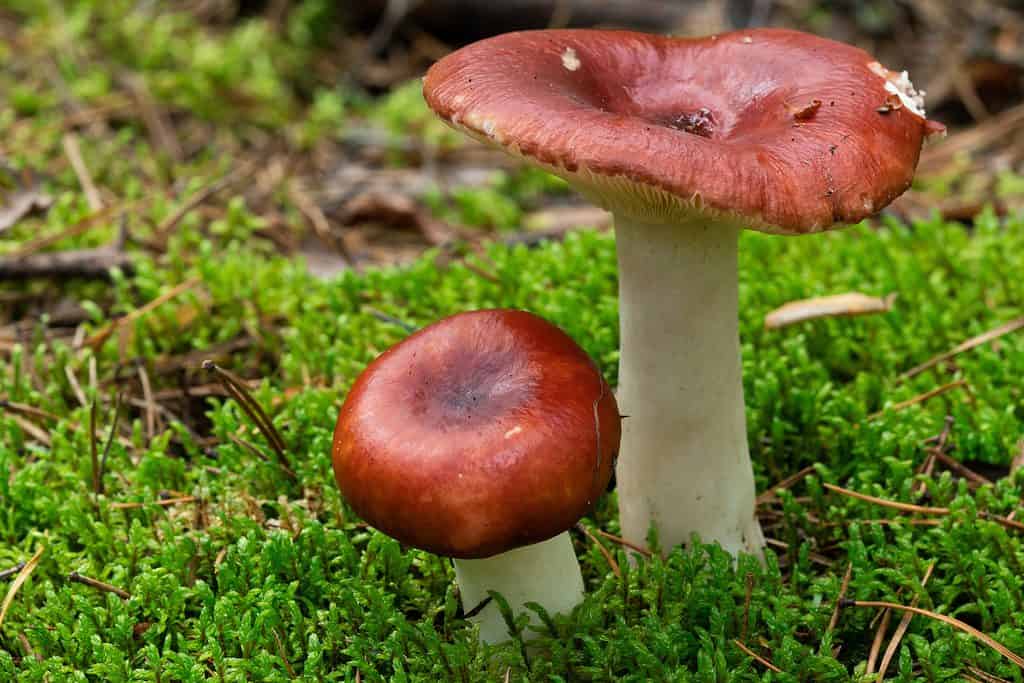
Edible Russula Paludosa mushroom growing in the moss.
©Aleksandrkozak/Shutterstock.com
Nicknamed brittlegills because of their looks and texture, russula mushrooms are an extremely common type of fungi in many locales of the world. They come in a huge range of colors and flavors and textures and sizes. They not deadly but they are also commonly known as “sickener” mushrooms (the russula emetica, specifically) because many of the species will make you ill.
Generically speaking, russula applies to multiple species of mushrooms. The russula is actually an extremely large genus of mushrooms, with over 750 species worldwide. They are ectomycorrhizal mushrooms, meaning they are symbiotic rather than parasitic.
They all have brightly colored caps, making them quite easy to spot, ranging from dark yellow to red and most shades between. The genus was first described officially by Christian Hendrik Persson in 1796. He placed moved the mushrooms as a tribe under the genus Agaricus in 1801, but eventually Samuel Frederick Gray recognized the mushrooms as a proper genus in 1821.
The name “russula” means red, which the mushroom gets for the most common color of the fungi.
Where Do Russula Mushrooms Grow?
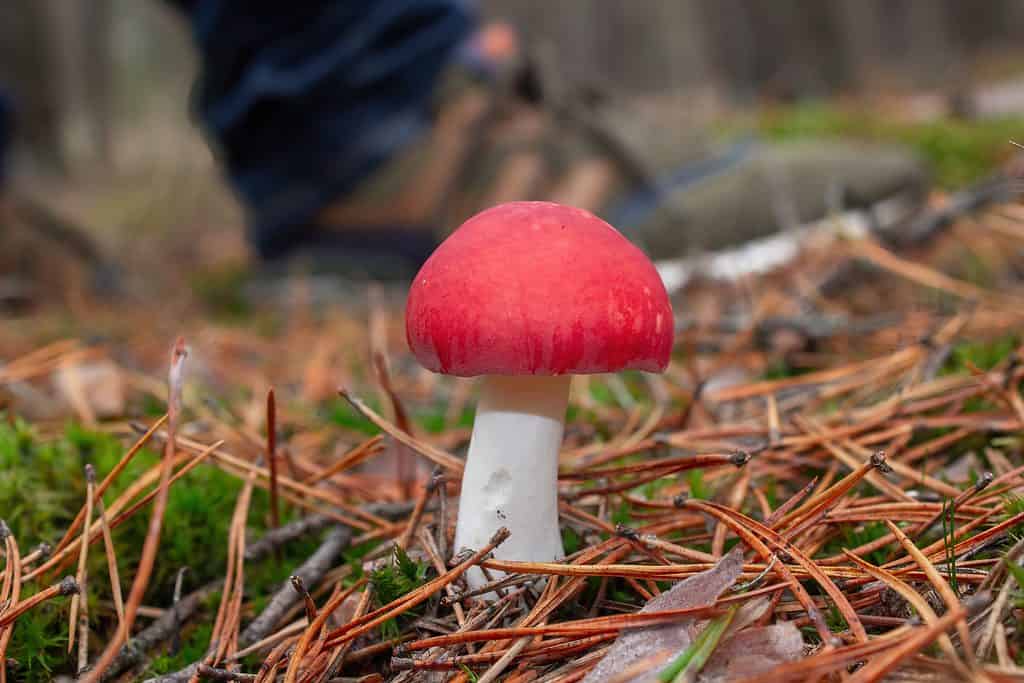
Red capped russula growing in wild
©Orbs production/Shutterstock.com
Russula mushrooms, of nearly every type, grow primarily in deciduous forests and woodlands or coniferous woodlands and forests. They may grow singularly, in groups, or scattered, and often are found among sphagnum moss and on extremely rotten wood.
They are common in North Africa, Asia, Europe, and North America.
Are Russula Mushrooms Safe to Eat?
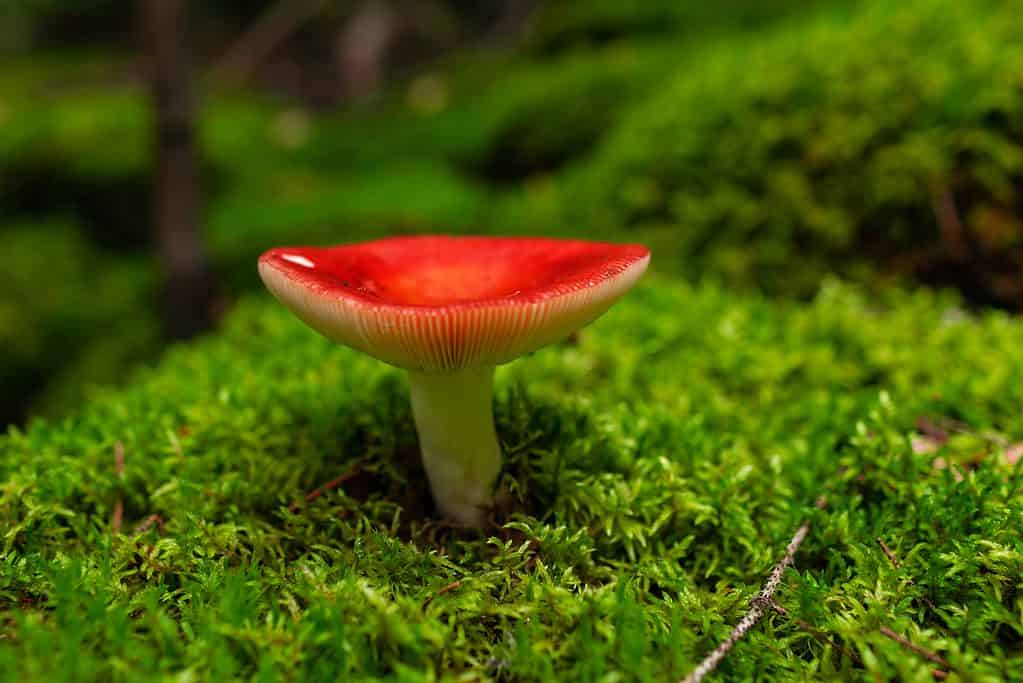
Red capped russula mushroom in moss
©Phant/Shutterstock.com
Technically, most varieties of russula mushrooms are mildly toxic. However, there are several species that may be eaten and there’s some debate over these, largely depending on where in the world you live. North American field guides are more prone to labeling most species inedible, for instance, while European field guides welcome more varieties into the edible category. Few of the species are gathered commercially, however, no matter who’s talking. The main symptoms of eating inedible russula are tied into the gastrointestinal system.
The edible species do have a wide range of flavors, though, and are among some of the favored edible species of mushrooms. The most popular edible species include the Russula cyanoxantha, a blue/green capped mushroom with a mild taste and white gills, Russula virescens, a green crackled cap mushroom, and the Russula xerampelina.
What Do Russula Mushrooms Taste Like?
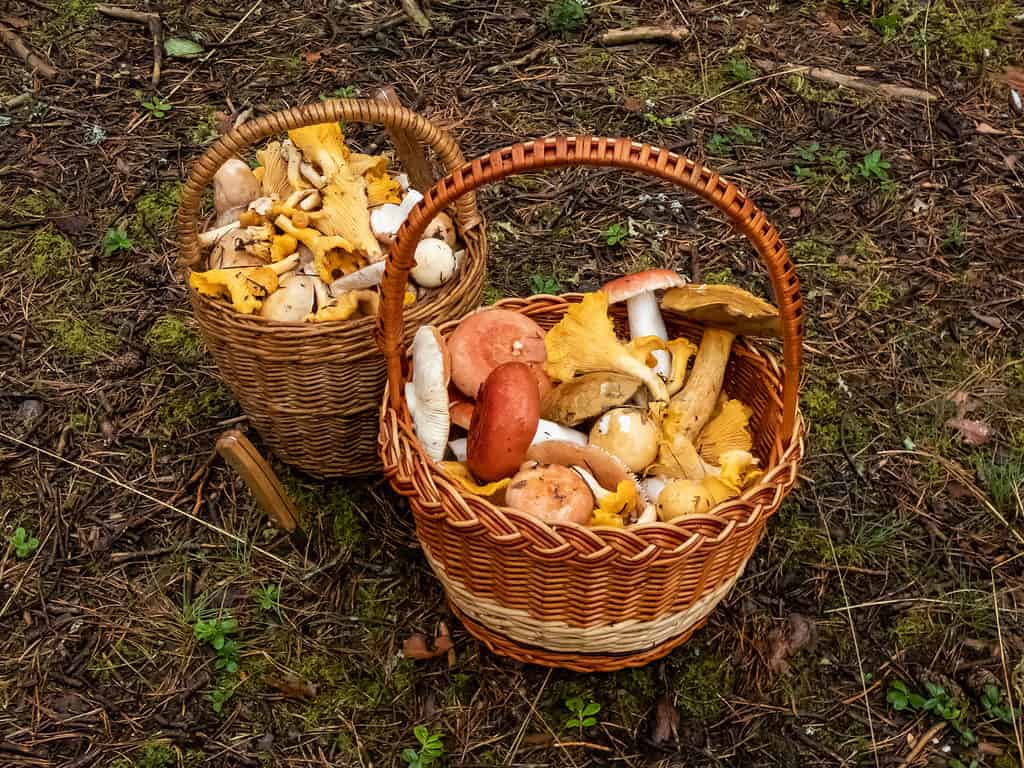
2 baskets of mushrooms from foraging
©Kristine Rad/Shutterstock.com
Typically, the smell of Russulas is described as “mildly mushroom-like.” The flavor ranges from mildly mushroom in nature, often a little peppery, to specific flavor profiles that make some stand out.
- Russula cyanoxantha is mildly flavored
- Russula virescens taste mildly nutty, fruity, or possibly sweet
- Russula xerampelina taste like seafood or more specifically shrimp
How Are Russula Mushrooms Used?
The edible russula mushrooms are most popularly eaten in Madagascar. All over the world, though, these mushrooms are used in a variety of dishes, such as stir fries, meat dishes, served with fish, in rice dishes, past dishes, and stews and soups.
Health Benefits

Russula mushrooms sauteed with onions and herbs
©andrey gor/Shutterstock.com
There are some medical benefits, potentially, for russula mushrooms. They contain antioxidants and are useful for antimicrobial activities in the human body. There have been studies showing both of these. They have long been used in Chinese traditional medicine, as well, for treating liver disease, chest pain, and eye problems. The R. delica has also had lectins isolated to help inhibit HIV-1 and treating AIDS.
Consuming mushrooms cannot cure diseases and should never be used as a substitute medication for any kinds of treatments. Always consult a medical care professional before adjusting dosages or dropping medications.
How Much Do Russula Mushrooms Cost?
Russula mushrooms are an extremely expensive mushroom, unfortunately, often pricing out at over $120.00 per pound, even in dried format.
They may be found online and in specialty stores.
How to Identify Russula Mushrooms

Russula virescens, an edible green russual mushroom
©Svarun/Shutterstock.com
There are a few ways to identify Russula mushrooms. One of which is the nibble test and should only be conducted if you are absolutely 100% sure that you have a russula mushroom in hand. Otherwise, the nibble could cost you much more than a bad taste in your mouth.
First, let’s identify visual context.
Russula mushrooms have extremely round caps that come in one single bright color. Beneath these caps, there will be crowded, white gills. There will be a stout white stem that’s grainy and has not skirt or ring at the base. The gills will flake away when you brush them with your fingers, the stems will snap like chalk, and the caps themselves will be firm but not brittle. The mushrooms will not release a milky substance when cut. The caps will be red, yellow, purple, green, white, or gray, most commonly. The mushrooms will be between 2.3 to 4 inches tall.
If you conduct the nibble test (we’ll talk about this below), the edible mushrooms will have a mild flavor while the harmful ones will taste bitter or acrid.
Russula Lookalikes
Before you head out to forage, beware that there are some russula lookalikes. The general rule with russulas is to avoid any red-capped varieties. There are other species that also look similar and are toxic. Again, avoid red caps to make sure you’re not getting into toxic areas.
The Nibble Test
WARNING: Never use this test on any other species of mushroom. It is only safe with russulas.
If you are absolutely 100% certain that you have a russula mushroom, you can attempt the nibble test. This is not really recommended, however, as most folks cannot be fully certain of the genus. If you’re with a mycologist, you’re more likely to be able to identify with certainty, however.
If you decide to do this, take a tiny nibble from the flesh of the mushroom and only slightly chew it. Do not swallow. Hold the flesh in your mouth on the tip of your tongue for 15 seconds. If the mushroom tastes mushroom-like and mild, then the mushroom is edible. If there’s a burning at all like spicy food, immediately spit it out and do not consume any of that mushroom.
Avoid the bright red capped russula mushrooms, as these are generally sickener species (meaning they will make your stomach hurt and may induce vomiting). Nibbling on these won’t harm you, but they won’t help you feel the best.
How to Forage for Russula Mushrooms

Bright yellow russula mushrooms growing wild
©sash2s/Shutterstock.com
Brittle gills, or russulas, are commonplace around the world, so many forests contain them. You’ll want to head specifically to coniferous or deciduous forests where you’ll find moist areas. Head in after a heavy rain for best results. Their peak season is between June and November. Look for them in small groups or growing solo.
When you head out, make sure you bring:
- Shears or a knife for cutting mushrooms
- Waterproof clothing and shoes to protect yourself from the damp
- A basket or bin for collecting mushrooms in
- Field guides, books, or identification apps to help ensure you’re finding the right mushrooms
- A GPS-enabled phone to make sure you can note where the mushrooms are found and where you car is!
- A notebook or writing app on your phone to take proper notes
Russula Mushroom Trivia
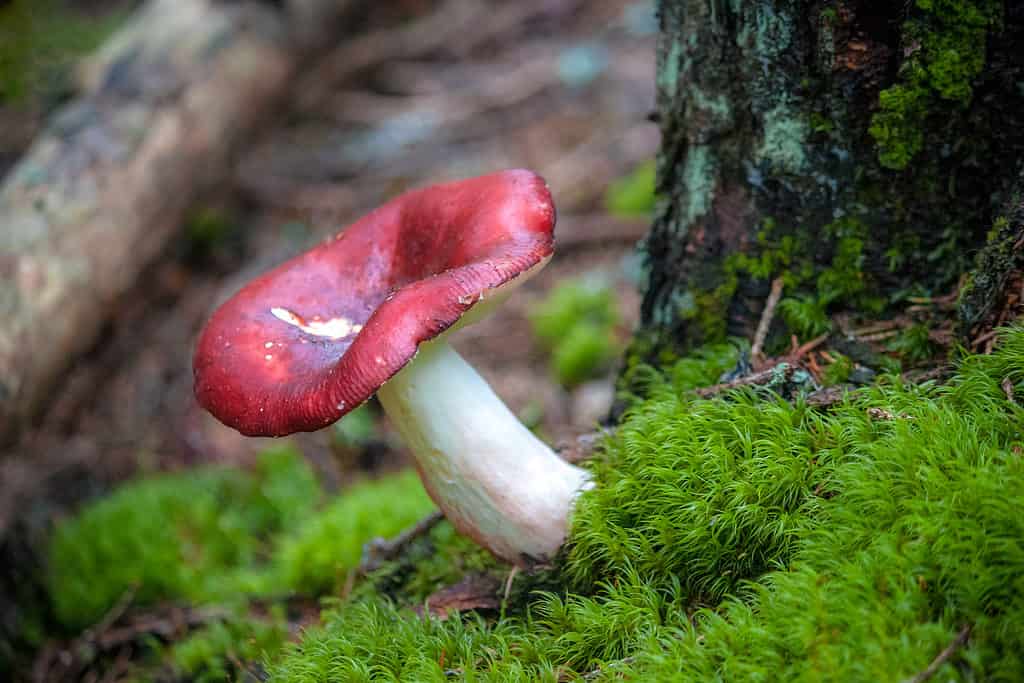
Reddish-brown capped russula mushroom growing in moss
©Viliam.M/Shutterstock.com
Russula mushrooms have many species within the genus, most of which will make you ill (induce vomiting, stomachaches, etc.) but won’t kill you. There are several varieties specifically nicknamed “the sickener” for this reason.
It is believed that the russula family split away from other mushrooms millions of years ago to take its own evolutionary path. They have round cells instead of oval cells like most other things in nature. This round cell shape is what gives them this unique texture when raw.
Milk cap mushrooms are the most closely related mushrooms to russula but they are not the same genus.
Up Next:
- Parasol Mushrooms: A Complete Guide
- What is the Best Month for Mushroom Hunting?
- The 8 Different Types of Lawn Mushrooms
- 9 Wild Mushrooms Found in Fall
The photo featured at the top of this post is © Phant/Shutterstock.com
The information presented on or through the Website is made available solely for general informational purposes. We do not warrant the accuracy, completeness, or usefulness of this information. Any reliance you place on such information is strictly at your own risk. We disclaim all liability and responsibility arising from any reliance placed on such materials by you or any other visitor to the Website, or by anyone who may be informed of any of its contents. None of the statements or claims on the Website should be taken as medical advice, health advice, or as confirmation that a plant, fungus, or other item is safe for consumption or will provide any health benefits. Anyone considering the health benefits of particular plant, fungus, or other item should first consult with a doctor or other medical professional. The statements made within this Website have not been evaluated by the Food and Drug Administration. These statements are not intended to diagnose, treat, cure or prevent any disease.
Sources
- Wild Food UK, Available here: https://www.wildfooduk.com/mushroom-guide/sickener/
- Totally Wild UK, Available here: https://totallywilduk.co.uk/2021/12/13/foraging-for-brittlegills-russulas/
- The Grizzly Forager, Available here: https://www.thegrizzlyforager.co.uk/russula-foraging-guide/
- Wild Edibles, Available here: http://wildedibles.teriin.org/index.php?album=Mushrooms/Russula
- Healing Mushrooms, Available here: https://healing-mushrooms.net/russula-emetica
- Wild Food UK, Available here: https://www.wildfooduk.com/articles/identifying-russulas/
- Wikipedia, Available here: https://en.wikipedia.org/wiki/Russula
Thank you for reading! Have some feedback for us? Contact the AZ Animals editorial team.






